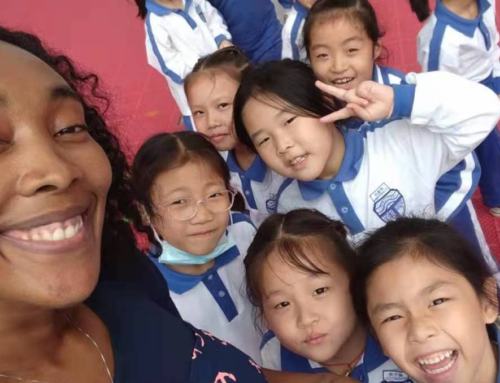Off to a Good Start
 It’s really important for teachers to create a positive and engaging classroom atmosphere. Research has indicated that if a positive classroom atmosphere is created, students will learn better and engage more which means that it is one of the most effective and powerful tools teachers can use to encourage children’s learning. Lots of factors are related to a positive classroom atmosphere, one important factor is how teachers respond to children’s behavior. Teachers’ responses to children’s behavior will help to set the tone of the class environment. This article will shortly focus on the teachers’ role in creating a positive classroom atmosphere and also a few simple suggestions for avoiding poor behavior from occurring.
It’s really important for teachers to create a positive and engaging classroom atmosphere. Research has indicated that if a positive classroom atmosphere is created, students will learn better and engage more which means that it is one of the most effective and powerful tools teachers can use to encourage children’s learning. Lots of factors are related to a positive classroom atmosphere, one important factor is how teachers respond to children’s behavior. Teachers’ responses to children’s behavior will help to set the tone of the class environment. This article will shortly focus on the teachers’ role in creating a positive classroom atmosphere and also a few simple suggestions for avoiding poor behavior from occurring.
Creating a Positive Teacher–Student Atmosphere
A positive classroom environment yields positive students who are motivated to learn. Creating a positive classroom is not that difficult, but the rewards are immense and far-reaching. Achieving this improves your professional achievement and the success of the students you are charged with teaching.
a) Smile to your students any time you see them
An important part of creating your positive classroom is to make your students feel like you want them to be there. To talk, teach and communicate positively. Your body language and tone of voice will also play important roles in comforting students.
Welcome your students with a smile, give them a big hug and tell them how glad you are to see them. Try to imagine that one day you went to school and saw your teacher wearing a straight face without even noticing you, you will keep wondering all day long: am I doing anything wrong? Things happen to children too, they can then be more sensitive and hesitant to participate. The power of their fondness for you, a hug or even just a smile in the hallway can have a big impact on their day. In return you’ll have a hard working student that is eager to please.
b) Avoid showing anger
Students can be naughty in class from time to time and teachers can get upset easily at times as well. The key to maintaining a positive attitude is to not show your anger. Remembering that your students are still developing social awareness as well as skills should give that extra bit of patience when required. Even adults can find it difficult to keep their emotions and actions in check. No matter how annoyed you may feel with a child, stay patient and calm. Don’t expect kids to behave perfectly. As they are exploring and discovering the world, children will make mistakes and they may do something you don’t like. There is something you can do to stop the students who aren’t doing what they should. What you can do in class is to distract them away from what is distracting.
For example, you can give the ones with high participation and good behavior some stickers or draw happy faces as a reward, or you can praise them with high enthusiasm and a loud voice. Get them involved in more activities to stimulate the naughty ones until they stop doing what the teachers don’t really like.
c) Keep oneself professional
Teachers can be moody and annoyed sometimes because of personal or professional events, but it’s important to know that separating the real-life you and the teacher you means a lot to your students and yourself.
One has to keep oneself professional when it comes to work, especially in teaching. You can’t spend a whole hour yelling at students because you got your purse stolen on the bus in the morning. Try to think each day that you spend in the classroom as a new opportunity to foster learning and that moment is unique in both you and your students’ lives. Always try your best to conquer the bad things that are annoying you.
d) Accept your students for who they are
 Not all kids were born with the same skills and abilities, or raised in the same environment. Not all students learn at the same level, no student is stupid and no question is a stupid question. Students’ knowledge of the world may vary from one another, so teachers should be open and patient to the ones who are asking questions or doing something that seems less than intelligent, and help them to solve their problems.
Not all kids were born with the same skills and abilities, or raised in the same environment. Not all students learn at the same level, no student is stupid and no question is a stupid question. Students’ knowledge of the world may vary from one another, so teachers should be open and patient to the ones who are asking questions or doing something that seems less than intelligent, and help them to solve their problems.
Parents are always going to dress their kids the way they want, and they are always pleased with what their children look like no matter how other people judge them, so it’s important to remember: keep your opinion to yourself. Never comment on a student’s appearance, each student is an individual. As far as classroom behavior is concerned, feel open to talk with parents about things they can do to help their kids to be better.
e) Positive communication with parents
Praise the children frequently and find something positive to say about each student. Positive communication with parents back home is important. Parents like to hear about what their kids are doing, and kids love to be complimented in the presence of their parents.
Suggestions for Creating a Positive Classroom
When you engage students so that they become more responsible for their learning and take control of themselves, they begin to realize the benefits of being more independent and accountable in the classroom. These are a few simple suggestions for creating a positive classroom environment so that we can enhance our enjoyment of our jobs and our success as teachers.
a) Establish classroom routines
It may take preschool and kindergarten kids a while to remember routines and classroom manners, but once the majority of the children get in the rhythm of classroom routines, they teach the other students. They also learn from each other and supervise each other. The outcome is more positive classroom behavior. Keep routines and rules simple and teach one or two at a time, for the long term it will benefit the teacher and students a lot without pushing students too hard.
b) Involve all the students in classroom activities
We may have noticed that children’s abilities in making friends in a new environment are different. Some children become the centre of the group immediately once they are here, and some children just keep to themselves all the time or try to behave badly in class. One of the possible reasons is that they lack the skills to make friends. It takes teachers wisdom to solve these problems. It takes time to investigate children’s preferences in class: whom does he or she like to sit or play with? What games or activities make him or her more confident? Assign different children to small groups regularly to avoid cliques from forming, play plenty of games that not only involve learning social skills but also some other skills more children may enjoy or be good at.
c) Encourage the students with positive feedback
Children are glad to be praised by nature, an uncomfortable atmosphere of competition can arise when children hear other children being praised and they are not. So try to hold a wider range in behavior you would like to praise. For example: “Thank you Tom for picking up Jerry’s pen”. Tom may be a naughty and have behavior issues in class, but he is always trying to help the others with whatever he can. Don’t judge him by not working hard in learning, praise him for his kindness. Feel free to talk with his parents about his warm-heartedness, and figure out a way to combine this quality in his learning.
d) Offer students more choices
Being a child has always been tough! They are told not to do this and not to do that. Just try to give them more choices, have them feel free to choose between crayons or felt markers, brown paper or blue paper, glue or tape. It’s necessary for teachers to know: choices are not always theirs, they can’t sit next to the one they always want to talk to, and they can’t do things that cross the line. Give them choices when you can.
e) Learn to be an expert communicator
 When a child refuses to do something, take a moment to check if there is something bothering him or her. They could be hungry, tired or sick. Children often do not have the vocabulary to explain why they feel uncomfortable or to express their feelings. So it’s important for teacher to sense the expressions on their faces, their movements, and try to figure out what they need or want. I have a 3- year-old boy in my class who once wet his pants without any warning, not until I saw the wet floor did I notice that he had peed. Then it turned out that he was frightened to tell me that he wanted to go to bathroom, and no one else before told him he could tell the teacher when he needed to.
When a child refuses to do something, take a moment to check if there is something bothering him or her. They could be hungry, tired or sick. Children often do not have the vocabulary to explain why they feel uncomfortable or to express their feelings. So it’s important for teacher to sense the expressions on their faces, their movements, and try to figure out what they need or want. I have a 3- year-old boy in my class who once wet his pants without any warning, not until I saw the wet floor did I notice that he had peed. Then it turned out that he was frightened to tell me that he wanted to go to bathroom, and no one else before told him he could tell the teacher when he needed to.
Communication with kids is an absolute necessity for a teacher. Children’s behavior is often unpredictable, illogical and based on their emotions. Learning to utilize effective communication techniques to establish positive classroom behavior will greatly help us in creating a harmonious and positive classroom atmosphere.
Conclusion:
Every student must feel safe and important in the class in order for maximum learning to take place. A positive classroom environment does not just happen; the teacher creates it. Becoming an effective teacher takes time, hard work, and dedication; we can have a long way to go in creating a better learning environment for learners. Once we realize its importance and continuously try something new when faced with issues, things will change.

















I am planning to teach in Cuba asap. Please put me forward through any contacts , Ive completed my TEFL course, expecting my certificate today. Please call me on 07720864660, to discuss.
Your ideas are wonderfull but i am more than 50 and couldn,t tolerate the bad behaviour of ss